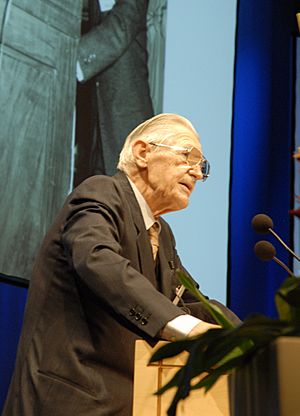Franz Pacher facts for kids

Franz Pacher was an important Austrian engineer. He was born on April 28, 1919, in Prostřední Suchá, which is now part of the Czech Republic. He passed away on March 3, 2018, in Salzburg, Austria. Franz Pacher was a pioneer in building modern tunnels. He was one of the main people who helped create the New Austrian Tunneling method (NATM). This method changed how tunnels were built around the world. Later in his career, he was involved in almost 90% of all tunnel projects in Austria.
Contents
Early Life and Education
Franz Pacher finished high school in Graz. After that, he studied civil engineering at the Technical University of Graz. He graduated from the university in 1943.
Career
After graduating, Franz Pacher stayed at the Technical University of Graz. He worked there as a research assistant until 1945. He focused on hydraulic engineering, which is about water systems. From 1946 to 1952, he worked on power plant construction sites. During this time, he first learned about rock mechanics and tunnel building.
In 1952, he joined Leopold Müller’s company. This company focused on geotechnics (studying the Earth's materials) and tunnel construction. In 1957, Pacher became Müller’s business partner. By 1966, he was the only manager of the company. Together, Pacher and Müller made big improvements in rock engineering. They helped start the modern age of tunnel building in the mid-1960s.
Before 1975, Pacher also worked closely with Professor Ladislaus von Rabcewicz. Their teamwork was very important for how tunnels were designed and built. In 1983, Franz Pacher changed his company into the Ingenieurgemeinschaft für Geotechnik und Tunnelbau (IGT). This means "Engineering Group for Geotechnics and Tunneling Construction." He finally retired in 1988.
Projects
Pacher worked on many important projects. One was the Schwaikheim Tunnel in Germany. This was the first tunnel in Germany built using shotcrete principles. Shotcrete is a type of concrete that is sprayed onto a surface. He also helped plan the subway systems in Munich and Vienna. He gave advice during their construction.
Between 1968 and 1975, he worked on the Tauern Road Tunnel and the nearby Katschberg Tunnel. These are in the state of Salzburg. From 1981 to 1985, he led tunnel construction for a new German railway line. This line connected Hanover and Würzburg. This work included the Landrücken Tunnel. He also helped build power plants. These included the Hirzmannsperre power plant in Styria and the Dürrach dam in Tyrol. He also worked on the turbine plant for a textile factory in Reutte. While working for Leopold Müller, Pacher also helped check the anchoring of the Vajont dam.
Contributions
Franz Pacher made big steps forward in basic research. He helped define how cracks and spaces in rock are measured. He also developed the "ground reaction curve." In 1964, he introduced the "Pacher-Fenner curve" in a publication. This method helps predict and show how ground pressure and tunnel support interact. This led to the "convergence-confinement method." In 2009, Pacher created a diagram. It showed how ground pressure and changes in shape depend on time.
Teaching
From 1966 to 1987, Pacher taught about rock mechanics. He lectured at the Technical University of Munich. From 1979 to 1983, he was a lecturer in Applied Rock mechanics at the Vienna University of Technology.
Other Professional Activities
From 1975 to 1987, Pacher led a special committee. This was the Working Committee on Tunneling at the Research Association for Transport and Roads. Pacher also gave many talks and wrote many articles for professional journals.
Memberships
From 1969 to 1999, he was part of the Subcommittee on Dam Surveillance. This was at the Austrian Federal Ministry of Agriculture, Forestry, Environment and Water Management. From 1966 to 1988, he was an expert in rock mechanics. He served on the reservoir commission at the Austrian Federal Ministry of Agriculture and Forestry, Environment and Water Management.
After 1984, he was a member of the Road Research Advisory Board. This was at the Austrian Federal Ministry of Economics. He also helped start two important groups. He was a founding member of the International Society for Rock Mechanics (ISRM) in 1962. He also helped found the Austrian Society for Geomechanics in 1968. From 1975 to 1981, he was the president of the Austrian Society for Geomechanics.
Awards
- In 1975, he received an honorary doctorate. This was from the Faculty of Civil Engineering and Surveying at the University of Karlsruhe.
- In 1977, he was made an honorary professor. This was in the Department of Civil Engineering and Surveying at the Technical University of Munich.
- In 1979, he was given the special professional title "Baurat h.c."
- In 1994, he received the Golden Medal of Honor from the State of Salzburg.

